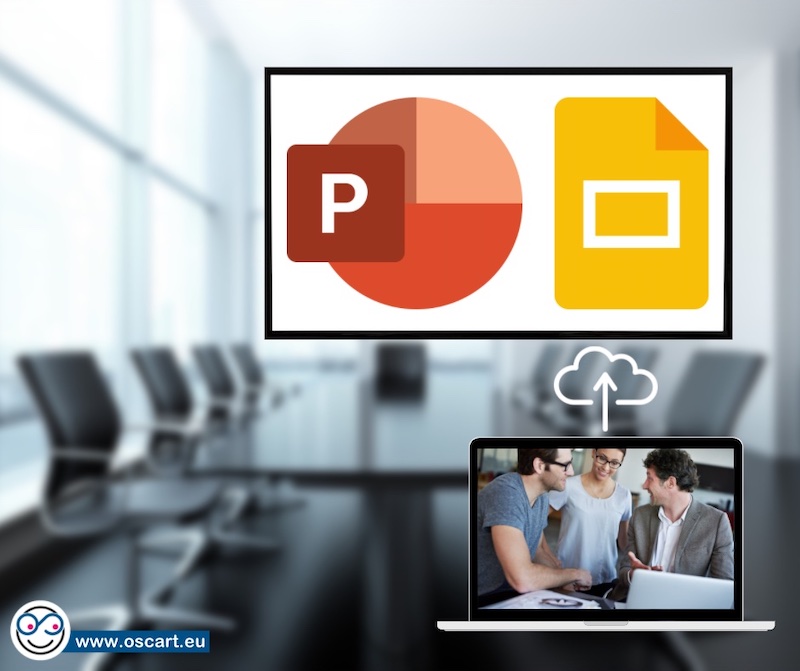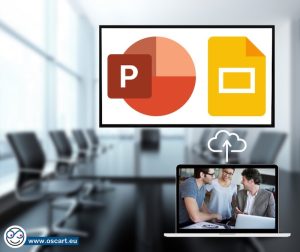Google Slides and especially Microsoft PowerPoint are among the most commonly used tools to create company or product presentations. You may also have invested a lot of time in creating document templates in which you use a corporate identity. Or perhaps you have an interesting and good presentation that you would like to exhibit effortlessly on your digital signage screens to your customers, visitors or employees?
With Oscart this is child's play. There are several options to achieve this. Below you will find the outlines of 3 methods to bring your presentation to your screens.
Method 1. Export your presentation to images or video and import the files into Oscart
From PowerPoint and Google Slides you can easily and quickly export all slides to separate JPEG files.
In PowerPoint, choose File > Export. For the file format, select JPEG to download all slides as individual images or MP4 if you want the presentation as a video. In Google Slides, choose File > Download > Jpeg Image. Unfortunately, you have to do this slide by slide. You can also download your Google Presentation as a PowerPoint file and then use PowerPoint to perform the same actions as above. Or download as PDF and then export the individual pages as JPEG with a 3rd party tool.
Open your web browser and log in to your Oscart customer area. Select the files you downloaded in Explorer (Windows) or Finder (macOS) and drag them to the drop zone that says “Drop your files here” (bottom left). Now all files are uploaded to the Oscart media library. You then create a new page via Digital Signage > Pages > New. Give your page a name and add an image zone via the + symbol (or video zone if you're working with a video). Oscart then allows you to choose one or more images. Select the newly uploaded slides, adjust the animation effects and order if necessary. Finished!

Method 2. Post your presentation on the internet, and create a screen page in Oscart that loads your presentation in an iframe
In Google Slides, proceed as follows: open the presentation and choose “Publish to web” from the File menu. Then select the “Insert” tab on the next screen. There you activate both options to automatically (re)start the slideshow and adjust the size if necessary. Then you copy the HTML code but only keep the text that becomes the source of the iframe. This is the text in quotes that is the URL of the presentation, and that we use in Oscart. Create a new page in Oscart and add an iframe widget/zone. Adjust the settings of the zone (size on full screen, usually 1920 x 1080). Go to zone content and insert the text copied above (URL without quotes) as the value for Url. Save the page and add it to a playlist. Finished!
There is an analogous method for PowerPoint. In the most recent version of PowerPoint (where
the presentation is saved on OneDrive or SharePoint), choose Share > Copy Link from the File menu. PowerPoint then generates a URL that you can publish on your Oscar screens in the same way as described above for Google Slides. Make sure that access to the presentation must be activated for “Everyone”.
And this is also the disadvantage of this method: anyone who knows the URL can view the presentation. In other words, do not use this method for confidential information. Advantage of this method: if you now change the original presentation, the changes will be automatically and immediately visible on your Oscar screens.
Method 3. Place your slides as images in Dropbox and let Oscart automatically visualize all slides
This is largely the same method as the first with the big difference that you do not upload the images or video to the Oscart media library but export them to a folder on Dropbox. You then create a page in Oscart on which you place a Dropbox zone/widget that monitors this folder. Oscart will automatically pick up all images in the folder and adjust your screens immediately. So here too, the big advantage of this method is that you don't have to do anything in Oscart itself when your presentation changes.
